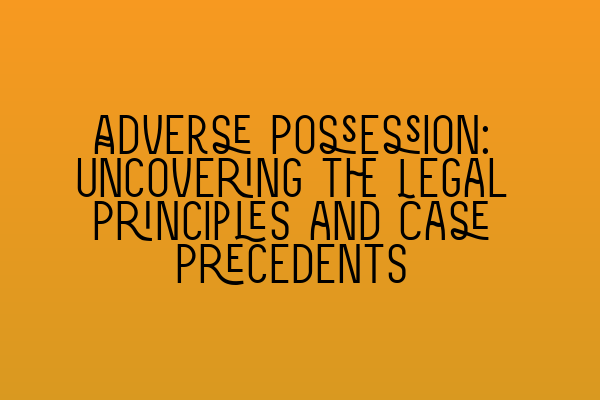Adverse Possession: Uncovering the Legal Principles and Case Precedents
Welcome to another informative blog post by SQE Property Law & Land Law! Today, we will be diving into the intriguing world of adverse possession. Have you ever wondered how someone can acquire legal rights to a property by simply occupying it for a certain period of time? Well, adverse possession is the legal principle that allows precisely that. In this post, we will explore the fundamental principles and case precedents that govern this fascinating area of property law.
What is Adverse Possession?
Adverse possession is a concept rooted in common law that allows an individual to gain the legal rights to a property they have occupied and maintained in an open and continuous manner for a certain period of time, typically 10 to 12 years. By adhering to specific requirements, an adverse possessor can effectively extinguish the legal rights of the actual owner and claim the property as their own.
Legal Requirements for Adverse Possession
To succeed in adverse possession, certain key requirements must be met. These include:
1. Actual Possession: The adverse possessor must physically occupy the property and treat it as their own. Mere intention or occasional use is not sufficient to establish adverse possession.
2. Open and Notorious Possession: The adverse possessor’s occupation of the property must be visible and apparent to anyone with a reasonable level of observation. Essentially, it should be obvious to the world that the property is being possessed by someone other than the legal owner.
3. Exclusive Possession: The adverse possessor must exclude others, including the legal owner, from using or entering the property. This is essential to demonstrate that the possession is adverse and not permissive.
4. Continuous Possession: The adverse possessor must occupy and maintain the property continuously for the required period of time. Any interruptions or temporary absence may undermine the claim of adverse possession.
5. Hostile Possession: The term “hostile” in this context does not necessarily imply aggression or ill intent. Rather, it means that the adverse possessor is occupying the property without the legal owner’s permission. The possession must be inconsistent with the legal owner’s rights.
6. Statutory Period: Different jurisdictions have varying statutory periods that determine the length of time required for adverse possession to be established. Generally, this ranges from 10 to 12 years, but it is crucial to consult local laws to determine the specific timeframe.
Notable Case Precedents
Over the years, numerous landmark cases have shaped the principles surrounding adverse possession. Some notable examples include:
1. Pye v. Graham: This case, heard by the House of Lords in 2002, concerned a dispute over an area of land occupied by the plaintiff for over 12 years. The court held that the adverse possessor was entitled to the land, emphasizing the importance of adherence to the necessary requirements.
2. JA Pye (Oxford) Ltd v. United Kingdom: Another case involving Pye, this time taken to the European Court of Human Rights, highlighted the delicate balance between the rights of adverse possessors and the legitimate interests of property owners. The court ruled in favor of Pye and reaffirmed the principles of adverse possession.
3. Buckinghamshire County Council v. Moran: In this case, the court considered the adverse possession of a highway, leading to a notable extension of the principles of adverse possession beyond traditional non-public properties.
Implications and Considerations
Adverse possession can have significant implications for both property owners and adverse possessors. Property owners need to be aware of their rights and take appropriate action to protect their property from potential adverse possession claims. On the other hand, adverse possessors must carefully navigate the legal requirements to establish a solid claim.
Conclusion
Adverse possession is a complex and fascinating area of property law that has the potential to dramatically alter ownership rights. By meeting certain requirements, an adverse possessor can acquire legal rights to a property, effectively extinguishing the rights of the original owner. Understanding the principles and case precedents surrounding adverse possession is crucial for property owners, legal professionals, and anyone interested in the intricacies of property law.
If you found this article informative and would like to explore more legal topics related to the SQE exams, be sure to check out our other articles here:
– SQE 1 Practice Exam Questions
– SQE 1 Practice Mocks FLK1 FLK2
– SQE 2 Preparation Courses
– SQE 1 Preparation Courses
– SRA SQE Exam Dates
Thank you for reading, and we hope you found this article enlightening. Stay tuned for more valuable content from SQE Property Law & Land Law!
